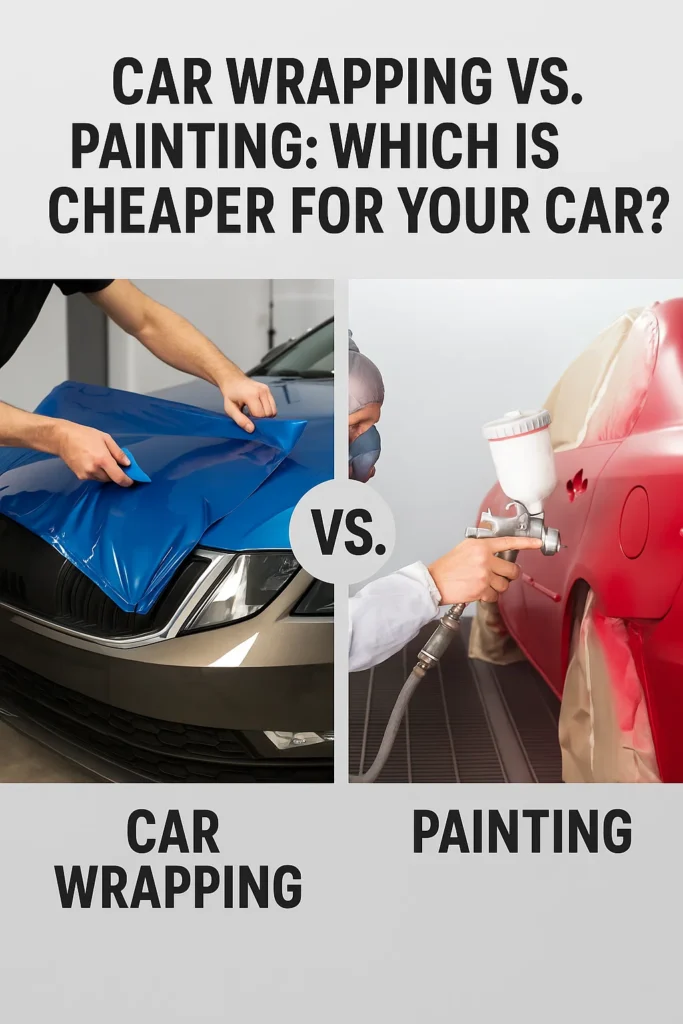Car wrapping vs. painting — which is right for your car? Compare costs, durability, appearance, maintenance, and resale value to make an informed choice.

What Is Car Wrapping?
Car wrapping is the process of covering a vehicle’s exterior with a vinyl film to change its color or appearance. It’s a non-permanent solution that protects the original paint and allows for easy customization.
Wraps come in a variety of finishes, including:
- Gloss
- Matte
- Satin
- Chrome
- Carbon Fiber
- Color-shifting and Textured Designs
Wraps are typically applied in panels, such as the hood, doors, or fenders, and can be removed without damaging the underlying paint.
What Is Automotive Painting?
Automotive painting involves permanently changing a car’s color using professional paint sprayers and baking booths. It requires prepping the surface through sanding, priming, and multiple layers of paint and clear coat.
Paint jobs can vary from a basic factory match to high-end custom airbrushing or pearl finishes. They offer a more “natural” and permanent change compared to wraps.
Cost by Vehicle Size and Customization Level
Larger vehicles and complex customizations significantly raise costs. Wraps tend to be more budget-friendly for dramatic changes, while custom paint jobs can become very expensive.
Time Investment and Turnaround Time
- Car Wrap Installation: 2–5 days
- Professional Paint Job: 1–3 weeks (including prep and curing)
Wraps offer a faster turnaround, making them ideal for temporary style updates or promotional designs.
Appearance and Finish Options
Variety and Customization Flexibility
Wraps provide unlimited possibilities: digital prints, patterns, textures, and even glow-in-the-dark options. Paint is more restricted by complexity and cost.
Wraps excel in uniqueness, while paint excels in depth and authenticity.
Durability and Longevity
- Wraps: 5–7 years (premium materials)
- Paint: 10–15 years (with proper care)
Paint lasts longer but is harder and more expensive to repair. Wraps may need replacing sooner, but are cheaper to touch up or reapply.
Resistance to UV, Scratches, and Weather
High-end PPF and laminated wraps resist UV rays and light scratches, while paint may fade or oxidize over time without coating protection.
Protection and Paint Preservation
Wraps act as a shield for your OEM paint, preserving the car’s resale value. Paint does not protect the underlying surface—it is the surface.
Maintenance and Upkeep
| Feature | Wrap | Paint |
| Cleaning | Hand wash with wrap-safe soap | Regular car wash or polish |
| Waxing | Not required (unless ceramic coated) | Recommended for shine & protection |
| Repairs | Re-wrap individual panels | Sanding, repainting required |
Resale Value Impact
Wraps can actually increase resale value by preserving the factory paint. They are removable, meaning the next owner can return the car to original condition.
Custom paint jobs may reduce value if the color or design doesn’t appeal to a wider audience.
Reversibility and Flexibility
- Wraps: Fully reversible — perfect for leased vehicles or temporary looks
- Paint: Permanent, requires full repainting to change
Environmental Considerations
- Painting uses solvents and produces VOCs (Volatile Organic Compounds)
- Wrapping is cleaner, generates less waste, and is more eco-friendly
When to Choose Wrapping Over Painting
- You want to protect factory paint
- You desire fast transformation
- You need temporary branding or ads
- You’re working with a lower budget
When Painting Might Be a Better Choice
- Your vehicle’s paint is severely damaged
- You want a permanent, OEM-quality finish
- You’re restoring a classic or collectible car
FAQs: Car Wrapping vs. Painting
Q1: Can a wrap look like real paint?
Yes. High-quality wraps mimic paint finishes very well—especially gloss and satin options.
Q2: Can you wrap over old or damaged paint?
It’s possible, but not recommended. Wraps stick best to clean, smooth paint.
Q3: Is a wrap cheaper than paint?
Usually, yes—especially for exotic finishes like chrome or carbon fiber.
Q4: Can I wrap just part of my car?
Yes! You can wrap only the hood, roof, mirrors, or even use wraps for accents.
Q5: How long before paint cures after repainting?
Paint typically needs 30–60 days to fully cure before waxing or additional treatments.
Conclusion
When it comes to car wrapping vs. painting, the better option depends on your goals. If you want speed, customization, protection, and flexibility, go with a wrap. If you seek permanence, resale painting, or full restorations, painting is your route.
But for most modern drivers and businesses, car wrapping offers better value, faster results, and longer-term versatility—making it the smart choice in today’s automotive world.

